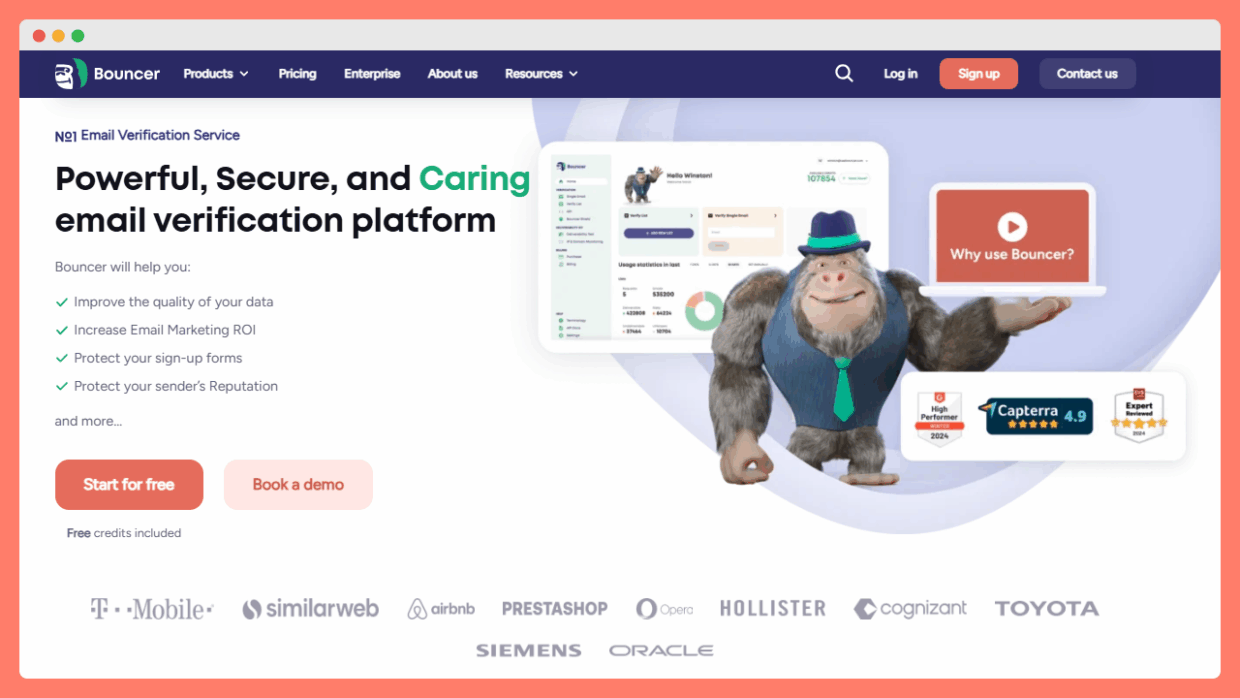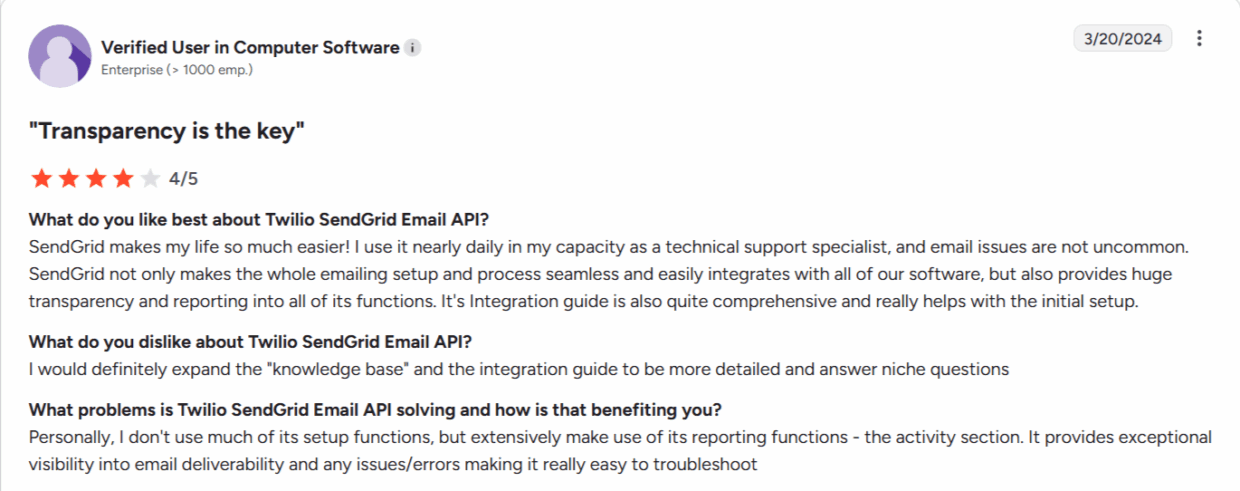One glitch in the process and you’re dealing with frustrated teams or missed opportunities. That’s why the tool you choose matters so much.
SendGrid and Mailtrap are two popular choices for reliable solutions for high-volume email sending.
They solve similar problems in different ways, and knowing what each one brings to the table makes your choice easier.
Here’s a walk-through of both so that you can find the right fit for your workflow.
SendGrid vs Mailtrap: platforms overview
Before comparing the individual features, let’s understand the platforms better.
SendGrid

G2: 4.0
Capterra: 4.2
SendGrid, now a part of Twilio, is a cloud-based email sending platform. As one of the oldest names in the industry, its infrastructure is a proven workhorse, capable of sending over 148 billion emails every month.
The platform is as useful for developers as it is for marketing teams. You can send transactional emails like password resets and order confirmations, or run full-fledged marketing campaigns with A/B testing and dynamic templates.
SendGrid is notable for its reliability at enterprise volumes. With real-time analytics, enterprise-level security, and flexible APIs, it is a solid choice when email is critical to your business operations.
Mailtrap

G2: 4.8
Capterra: 4.8
Mailtrap is an email delivery platform built for delivering email at scale. It serves a dual purpose of safe email testing in sandbox environments and reliable production sending through Mailtrap Email API. It’s ideal for dev and marketing teams handling marketing campaigns, bulk sends, and transactional emails.
Trusted by over 150,000 monthly active users, Mailtrap is best known for its industry-best analytics, which give developers granular insight into every step of an email’s journey.
All in all, it helps you debug, test, and securely deliver emails in production so they reach the inbox exactly as intended.
SendGrid vs Mailtrap: features comparison
Here’s a side-by-side, feature-wise comparison of SendGrid and Mailtrap:
| Feature | SendGrid | Mailtrap |
| Target use cases | Production-grade delivery at enterprise scale | Testing and production delivery for product teams |
| Authentication method | Mandatory API key, two-factor authentication, and domain authentication (SPF and DKIM) | Mandatory API tokens and domain verification, and two-factor authentication are mandatory for new devices |
| Testing & QA | Sandbox mode, primarily production-focused | Full sandbox with client previews and HTML checks |
| Integration resources | Guides and code samples | Guides and ready-to-use code snippets |
| Searchable email activity | Up to 7 days (extendable up to 30 days with a paid add-on) | Up to 30 days |
| Deliverability and analytics | Real-time analytics, deliverability insights, ISP feedback loop data, and engagement tracking | Full deliverability analytics, separate stats by mailbox provider, ISP feedback loop data, and deliverability alerts |
| Security features | Two-factor authentication, IP access management, SSO for higher plans, TLS, and SSL support | Two-factor authentication, IP whitelisting, SSO for higher plans, TLS, and HTTPS support |
| Developer tools | RESTful API, support in 7 programming languages | RESTful API, support in 6 programming languages |
| Rate limits | Varies by plan, with generous API request limits for high-volume sending | Varies by plan, sending rate limits per 10 seconds |
| Customer support | Tiered support with expert services available as a paid add-on | 24/7 ticket support across all plans with priority, and deliverability expert support on higher-tier plans |
1. API and SMTP capabilities
SendGrid is the heavyweight here. On higher-tier plans, it can handle up to 10,000 API requests per second. That’s enough to email a small city before your coffee cools.
It supports multiple languages, including C#, Go, Java, Node.js, PHP, Python, and Ruby. On the SMTP side, the server is smtp.sendgrid.net, with ports 25, 587, and 2525 for TLS, and 465 for SSL.
You also get access to advanced personalization with Handlebars templates, loops, and conditionals, so you can tailor messages for different audiences.
Mailtrap is like a careful craftsman. Its email API for high-volume sending helps you control emails, with limits based on your plan and structured to protect your sender reputation.
It works with Node.js, PHP, Ruby, Python, Elixir, and Java. For SMTP, the live.smtp.mailtrap.io host handles transactional emails, while bulk.smtp.mailtrap.io is for high-volume campaigns. It supports ports 25, 465, 587, and 2525.
Like SendGrid, Mailtrap’s template system supports Handlebars, including variable substitution, loops, and conditional logic. What sets it apart is the dedicated testing sandbox for safe, pre-production email checks. However, this is a separate product from Mailtrap’s email sending service.
So, the bottom line is that SendGrid suits ‘go big or go home’ operations, sending thousands of emails daily with complex personalization requirements. But if you want high sending capacity paired with built-in testing workflows, Mailtrap is the more focused choice.
2. Deliverability and reliability
SendGrid offers an exceptionally reliable infrastructure. It automates SPF and DKIM setup and offers detailed Deliverability Insights dashboards. This lets you monitor bounces, blocks, and your sender reputation with clients like Gmail and Yahoo. If you’re an enterprise customer, you can also access their expert services for a more hands-on approach.
Now here’s the catch. While SendGrid’s infrastructure is top-tier, the nature of its shared IPs can sometimes drag down your sender reputation if another user on that IP sends spam. SendGrid addresses this by offering dedicated IPs on its Pro and Premier plans, which give you full control over your reputation.
Mailtrap takes a slightly different route with a ‘deliverability-first’ philosophy. Along with authentication features like SPF, DKIM, and DMARC, it offers separate IPs for transactional and marketing emails. This means your critical password resets won’t suffer just because you blasted a sales promo to your entire list. It also offers free deliverability expert support on higher-tier plans.
Mailtrap’s IP separation helps mitigate this risk entirely, giving your time-sensitive emails a cleaner path to the inbox.
However, maintaining high deliverability doesn’t rely only on a strong infrastructure. It also depends on sending to valid, engaged addresses. In high-volume sending, even a small percentage of invalid or fake emails can spike bounce rates, trigger spam filters, and damage your sender reputation.

Bouncer addresses this by accurately validating and cleaning large email lists. It filters out invalid contacts and detects spam traps with precision.
It’s fast too, processing up to 180,000 emails per hour with minimal unknowns. The result is that your SendGrid or Mailtrap campaigns land in real inboxes, while keeping your reputation intact and your sending costs in check.

SendGrid vs Mailtrap: pricing for high-volume senders
SendGrid and Mailtrap’s pricing is not a simple apples-to-apples comparison. They package their services differently.
SendGrid separates transactional email APIs from its marketing campaign services, so you’ll need to budget for each separately if you want both.
Mailtrap, however, offers a simpler solution. It gives you a unified pricing model, covering both transactional and marketing emails in one plan. So, you get what SendGrid offers plus a little extra, in an affordable price range, without having to buy two plans.
Below is a comparison of SendGrid’s Email API plans with Mailtrap’s email sending plans.
| Platform | Plan | Monthly Email Volume | Price | Features |
| SendGrid | Essentials | 50,000-100,000 emails | Starting at $19.95/month | APIs, SMTP relay, analytics, suppression management |
| Pro | 100,000-2,500,000 emails | Starting at $89.95/mo | All Essentials with dedicated IP, subuser accounts, SSO | |
| Premier | Custom volume | Custom pricing | All features with advanced scaling and high-touch support | |
| Mailtrap | Basic | 10,000+ emails | Starting at $15/month | Email API, SMTP relay, drag-and-drop editor, IP whitelisting |
| Business | 100,000+ emails | Starting at $85/month | All Basic with dedicated IP, analytics, and priority support | |
| Enterprise | 1,500,000+ emails | Starting at $750/month | All of the above and advanced security, and 30-day log retention | |
| Custom | From 1,500,000 | Custom | All of the above and added support |
Apart from this, SendGrid offers a 60-day free trial where you can send 100 emails per day. On the other hand, Mailtrap offers a free forever plan that allows up to 150 emails per day, where you can try out Mailtrap’s basic services.
Which platform is right for you?
Here’s a quick comparison to help you choose the right platform based on your team’s specific needs and priorities.
| Requirement | Best Choice | Why |
| High-volume transactional emails | SendGrid | Established infrastructure, reliable scaling, deep analytics, and dedicated IPs for high-volume control |
| Testing and QA before production | Mailtrap | Full sandbox, fake SMTP, spam analysis, and staging environments designed for pre-production testing |
| Advanced marketing features | SendGrid | A separate, full-featured marketing platform with powerful campaign automation and integrations |
| Proactive inbox placement | Mailtrap | Proactive deliverability tools, IP separation, and granular analytics to manage reputation from day one |
| Budget-conscious use | Mailtrap | More affordable with a free plan for testing |
| Security controls | Both | Both offer strong security. SendGrid provides SSO on Pro plans, while Mailtrap offers fine-grained access roles and compliance features |
SendGrid pros & cons
Pros
- Flexible subuser management: Allows you to create and manage multiple subuser accounts with separate sending reputations, permissions, and API keys. This helps businesses manage multiple brands or departments.
- Inbound Parse Webhook: Converts incoming emails into structured data that can be processed by your app in real time. This enables features like automated ticket creation or CRM updates.
- Comprehensive security and compliance: As an enterprise-grade solution, SendGrid is certified with SOC 2 Type II, ISO 27001, and is GDPR compliant, which is critical for handling sensitive data at scale.
- Extensive integration ecosystem: Connects seamlessly with CRMs, analytics platforms, eCommerce tools, and custom apps through APIs and pre-built integrations.
Cons
- Potential for compromising account: If API keys or credentials are stolen, attackers can send phishing emails through legitimate infrastructure, bypassing SPF and DKIM checks and damaging sender reputation.
- Limited marketing automation: Offers fewer advanced automation features than dedicated email marketing platforms, so complex multi-branch workflows may require extra tools.
- Slower customer response times: Users sometimes experience delays in support resolution, especially on lower-tier plans.
- Complex scaling costs: Pricing can rise quickly as sending volumes, API usage, or feature needs increase, making budgeting more challenging for growing teams.
Mailtrap pros & cons
Pros
- Sophisticated debugging with Fake SMTP: Allows you to test emails safely without sending them to real recipients, helping catch issues early in development.
- Comprehensive security compliance: The platform holds ISO 27001 certification and is GDPR compliant, which is non-negotiable for businesses in regulated industries.
- Reporting API: Provides access to detailed email activity and deliverability metrics, making it easier to analyze and optimize campaigns.
- Built-in IP warm-up and management: Automatically warms up dedicated IPs to improve inbox placement and reduce the risk of being flagged as spam.
Cons
- Limited email marketing features: Focuses primarily on email testing and deliverability rather than full marketing automation capabilities.
- Limited integration: While Mailtrap offers SDKs for a variety of languages, its integrations and automation capabilities are limited. It currently offers only Zapier integration for automation.
- Advanced features limited to higher-tier plans: Many powerful tools and security options require upgrading, which increases costs.
- No free trial: Although there is a free plan, Mailtrap doesn’t offer a free trial with access to paid features, which can make evaluation difficult before purchase.
SendGrid vs Mailtrap: ratings & user reviews
Before you make your final choice, let’s look at how real users rate SendGrid and Mailtrap based on their firsthand experiences and satisfaction levels.
1. Ease of use
SendGrid users often highlight its ease of integration with other software and strong analytics.

Mailtrap is widely praised for being beginner-friendly. It makes it easy for teams to set up and get going without complex configurations. Here’s an X user sharing their experience with Mailtrap.

2. Learning curve
Most users find SendGrid’s interface clean and straightforward once they get the hang of it. That said, beginners new to email infrastructure or API workflows might hit a bit of a learning curve at first.

Similarly, a few users reported needing extra time with Mailtrap’s API until they got comfortable.

3. Testimonials
In a nutshell, users love SendGrid for its reliable high-volume sending, powerful APIs, scalable infrastructure, and reporting capabilities. However, some users find it pricey.

Meanwhile, Mailtrap wins points for simplicity and helpful customer service, with a common request being more built-in marketing automation and trial options for paid plans.

Take the next step!
At the end of the day, no tool alone can guarantee email magic. You can lean into SendGrid’s powerful scale or Mailtrap’s precision focus, but remember that it’s the small details that make a big difference.
Keep your lists clean, monitor your reputation, and don’t let technical hiccups slow you down. Nail those basics, and your emails won’t just send, they will land, engage, and perform. And if you want to start on the right foot, validating your lists is the next step.
Want to start now? Validate your emails with Bouncer!


